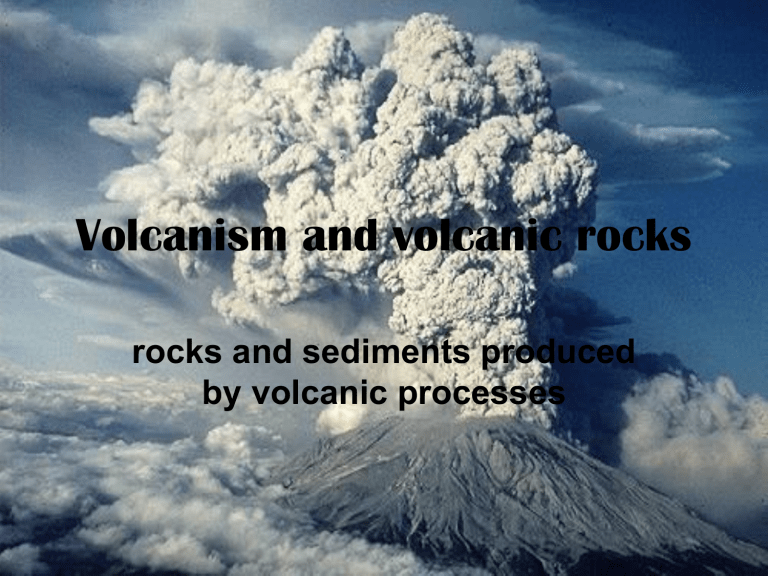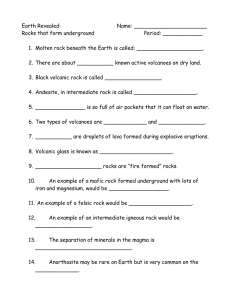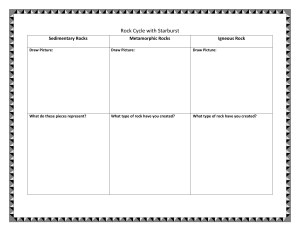
Volcanism and volcanic rocks rocks and sediments produced by volcanic processes Volcanism – plate tectonics relationship of volcanism to movements of the earth’s plates convergent boundaries • seduction zones – often violent eruptions, due to high silica content • pyroclastic sediments thrown from the volcano divergent margins – rifting divergent margins – rifting • under oceans – • basaltic lava – pillow lava • non violent eruptions, – composition of gabbro, – low silica content, – created by partial melting of the lowtemperature constituents of the mantle • on land – • plateau basalts – • non violent eruptions of – basalt flows from fissures (Iceland) – mantel material divergent margins – rifting • under oceans – • basaltic lava – pillow lava • on land – • plateau basalts – hot spots • stationary heat plumes in the mantle, hot spots in the mantle produce volcanoes in a chain as the crust moves over the hot spot (Hawaiian Islands) Eruptive Phenomena include • • • • • lava flows explosions ash falls hot-ash flows glowing avalanches • • • • • • mudflows fissures earthquakes floods elevation changes gas discharges • • • • • lava flows explosions ash falls hot-ash flows glowing avalanches • • • • • • mudflows fissures earthquakes floods elevation changes gas discharges types of lava • basic lava – produce non explosive eruptions or effusive eruptions, with lava fountains and lava flows, less viscous and thus does not trap gasses as much as the lava below • intermediate and acidic lava – produce explosive eruptions – sudden release of trapped CO2 and SO2 and steam in the highly viscous lava types of lava • basic lava types of lava • intermediate / acidic lava Warnings of an eruption mt. st. helens • begins with upward movement of magma from 50 km depth in the crust • earthquake swarms – up to hundreds per day due to the rise of magma • earthquakes at 1 km depth when the eruption is nearer at hand • temperature rise in hot springs and steam in volcanic crater • gas released causes asphyxiation • snow on the volcano will melt • bulge of the surface • explosion – casting pyroclastic debris up into the atmosphere (known up to 80 km) • Fall of pyroclastic debris (hot material) • base surge outward expanding ash-laden cloud which sometimes also contains poisonous acid or toxins On May 18, 1980, Mount St. Helens had a massive explosion that forever changed the picturesque alpine landscape, killed almost 60 people and sent ash for hundreds of miles. The force of the eruption coated eastern Washington with a thick layer of light gray ash. When wet the ash became as dense as cement making it hard to remove from lawns, roofs and roads. The ash can still be seen along I-90 and elsewhere in the area. Parts of Idaho and Montana had deposits as the ash was caught up in the jetstream winds. The blast removed 1000 feet off the top of the mountain, leveled 200 square miles of forest to the north, moved Spirit Lake and formed new lakes. The sound of the explosion could be heard as far away as Canada. Giant mudflows raced down the mountain into local rivers destroying bridges, vehicles and houses. The sound of the explosion could be heard as far away as Canada. Mount St. Helens is one of the Cascade Volcanoes that reach from Washington to California. events • glowing avalanches or nueé ardente is a hot (700-1000 degree C) ash-laden gas cloud • moves at extremely fast speed (average of 160 km/hr) down the volcano slope • rock formed by this is called ignimbrite or welded tuff events • lava flows – type of flow depends on viscosity which is related to silica content • stiff, highly viscous silica rich lava – flows in blocks and forms a blocky surface on the lava called aa texture • fluid, less viscous, lower silica lava – flows in rope like surface called pahoehoe texture • Hawaiian names events • Volcanic mudflows (lahars) • pyroclastic material mixed with water that flows rapidly (10 m/s) tsunamis • • • great sea waves caused by the displacement of water due to a sub oceanic volcanic eruption or earthquake great velocities up to 5 000 km / hr as they reach the shore they rise up into giant waves that flow in over the land tsunami tsunami tsunami tsunami tsunami Volcanic rocks • Pyroclastic rocks - molten material is ejected and solidifies in the air • classified as sedimentary rocks particles in volcanic rocks • preexisting rock particles are: blocks >64 mm, or lapilli 2-64 mm, • molten lava which cools are: bombs > 64 mm, ash-silt size pyroclastic rock names • Ash tuff - rock predominated by ash; sometimes simply referred to as tuff. • Lapilli tuff - rock predominated by lapilli. • Tuff breccia - rock containing 25% to 75% blocks and/or bombs. • Pyroclastic breccia - rock containing at least 75% blocks and bombs. • Agglomerate - rock containing at least 75% bombs. • Agglutinate - rock composed of fused, largely unrecognizable, basalt spatter fragments. pyroclastic rock names • pumice or scoria has numerous gas holes • obsidian is volcanic glass which cooled suddenly • bentonite – pure montmorillonite clay formed from weathered ash volcanic flow rock names in order of increasing silica (downwards) and increasing explosiveness 1. basalt 2. andesite 1. dacite 2. latite 3. rhyolite volcanic flow rock names in order of increasing silica (downwards) and increasing explosiveness 1. basalt 2. andesite 1. dacite 2. latite 3. rhyolite volcanic flow rock names in order of increasing silica (downwards) and increasing explosiveness 1. basalt 2. andesite 1. dacite 2. latite 3. rhyolite volcanic flow rock names in order of increasing silica (downwards) and increasing explosiveness 1. basalt 2. andesite 1. dacite 2. latite 3. rhyolite Volcanic rock terms • • • • • • • • • aphanitic – fine grains that are not visible to the eye phenocrysts – large crystals in the aphenitic matrix traprock – light colour aphanitic volcanic rock felsite – dark colour aphanitic volcanic rock vesicles – holes in the rock formed by gas bubbles vesicular – rocks with numerous vesicles scoriaceous – vesicular and extremely porous amygdule – mineral that fills the vesicle amygdaloida – a rock with numerous vesicles filled with minerals Volcanic rock terms • • • • • • • • • aphanitic – fine grains that are not visible to the eye phenocrysts – large crystals in the aphenitic matrix traprock – light colour aphanitic volcanic rock felsite – dark colour aphanitic volcanic rock vesicles – holes in the rock formed by gas bubbles vesicular – rocks with numerous vesicles scoriaceous – vesicular and extremely porous amygdule – mineral that fills the vesicle amygdaloida – a rock with numerous vesicles filled with minerals Volcanic rock terms • • • • • • • • • aphanitic – fine grains that are not visible to the eye phenocrysts – large crystals in the aphenitic matrix traprock – light colour aphanitic volcanic rock felsite – dark colour aphanitic volcanic rock vesicles – holes in the rock formed by gas bubbles vesicular – rocks with numerous vesicles scoriaceous – vesicular and extremely porous amygdule – mineral that fills the vesicle amygdaloidal – a rock with numerous vesicles filled with minerals Volcanic rock terms • • • • • • • • • aphanitic – fine grains that are not visible to the eye phenocrysts – large crystals in the aphenitic matrix traprock – light colour aphanitic volcanic rock felsite – dark colour aphanitic volcanic rock vesicles – holes in the rock formed by gas bubbles vesicular – rocks with numerous vesicles scoriaceous – vesicular and extremely porous amygdule – mineral that fills the vesicle amygdaloidal – a rock with numerous vesicles filled with minerals Volcanic rock terms • • • • • • • • • aphanitic – fine grains that are not visible to the eye phenocrysts – large crystals in the aphenitic matrix traprock – light colour aphanitic volcanic rock felsite – dark colour aphanitic volcanic rock vesicles – holes in the rock formed by gas bubbles vesicular – rocks with numerous vesicles scoriaceous – vesicular and extremely porous amygdule – mineral that fills the vesicle amygdaloidal – a rock with numerous vesicles filled with minerals Volcanic rock-mass characteristics • complex in composition, flows, pyroclastic debris etc. and interbeds of non volcanics • flows follow lows in the topography • resistant to weathering – after a long period of physical weathering the deposits which once were in the bottoms of valleys form tops of mountains, table mountains • irregular lateral extents Volcanic rock-mass characteristics • complex in composition, flows, pyroclastic debris etc. and interbeds of non volcanics • flows follow lows in the topography • resistant to weathering – after a long period of physical weathering the deposits which once were in the bottoms of valleys form tops of mountains, table mountains • irregular lateral extents Volcanic rock-mass characteristics • complex in composition, flows, pyroclastic debris etc. and interbeds of non volcanics • flows follow lows in the topography • resistant to weathering – after a long period of physical weathering the deposits which once were in the bottoms of valleys form tops of mountains, table mountains • irregular lateral extents Volcanic rock-mass characteristics • complex in composition, flows, pyroclastic debris etc. and interbeds of non volcanics • flows follow lows in the topography • resistant to weathering – after a long period of physical weathering the deposits which once were in the bottoms of valleys form tops of mountains, table mountains • irregular lateral extents fractures and permeability Weathering products • contrasting potential for weathering - basalt is more basic than granite and thus more inclined to decay due to chemical weathering • on one hand the rocks are often impermeable in themselves which would deter chemical weathering • on the other there are often numerous joint which make the rock mass on a whole very permeable, enhancing chemical weathering • young basalt often is not weathered, but old basalt is deeply decomposed to a clay soil, expansive montmorillonite Engineering problems with volcanism and volcanic rocks Enormous damage potential!! ash fall risks abrasive clogs drains poisonous causes fires •weight can damage structures (like water logged snow) Engineering problems with volcanism and volcanic rocks Enormous damage potential!! lava flow risks flow relative slow diversion possible; trenches, barriers and spraying with cold water can be used to deter the flow •predict flow path possible Engineering problems with volcanism and volcanic rocks Enormous damage potential!! mudflow risks huge quantity high velocities path predictable far in advance but the velocity and size of the flow makes it difficult to contain, dams are easily broken, barriers jumped preparatory measures can be taken, lower the level of water reservoirs Exploration and volcanic rocks • complexity of the deposits makes it difficult to predict their vertical and lateral extent • stratigraphy can vary greatly laterally • marker layers are needed • need to find the extent of the material with lower strength and high permeability Surface excavation • excavation often requires blasting • blocks often displaced on slopes; float in soft materials Underground excavations Difficulty can be represented by two cases 1) it took 6 years to tunnel 17 km 2) two years to tunnel 263 m Underground excavations large water inflow is common due to the: • open fractures and joint • highly permeable layers • permeable interbeds • folded beds can entrap water in compartments Underground excavations • hard and dense if unweathered – too hard for a tunnel machine • large extent of jointing results in high potential for rock fall – shortcrete required • horizontal stress zero, vertical stress = weight of the overlying rocks thus there is a high potential for the roof to collapse Underground excavations • active areas – poisonous gas can occur • young areas – non cemented rock common • warm water flows can occur Dams and canals • leakage is a great problem – grouting is required • compressibility high – bearing capacity poor • shear strength low – slides probable Dams and canals • Hoover dam, height 222 m • founded on volcanic breccia • grout curtain depth originally to be 40 m ended up 130 m deep and horizontally 90 m Dam in Sardinia • rock fill dam • concrete face • founded on a series of lava flows with columnar jointing and tuff beds • serious differential settling • fault under dam Engineering materials • volcanic rocks are used in all aspects of engineering • aggregates – concrete – asphalt • rock fill – dams – breakwaters – coarse grade • dimension stone Note: there are some things to look out for Problems as engineering material • volcanic glass reacts with alkalies in Portland cement = cracking of the structure • amygdules that are often filled with the following minerals: opal, zeolite, gypsum – these are not good in concrete, reactive • pillow lava has often an unstable rind which is reactive with Portland cement • weathering can be rapid for some rocks – X ten years = sand and gravel • disintegration tests should be made to test the life expectancy of the rock (top p.286) Case studies Protection of an Icelandic port from volcanism – barriers were erected and seawater pumped onto the flow to cool it Case studies Round Butte Dam, Oregon Case studies Round Butte Dam, Oregon • 133m high dam in lava flows with interbeds of non-volcanics. Fig 7.25 • Several layers required grouting • In all 42 km of grout holes were filled with 4000 m3 of Portland cement grout and took two years to carryout





